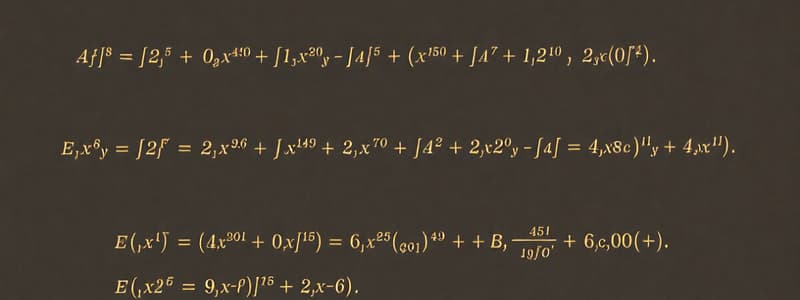Podcast
Questions and Answers
Which of the following best describes the difference between an expression and a formula?
Which of the following best describes the difference between an expression and a formula?
- Formulas can only contain numerical values; expressions can contain both numerical values and variables.
- An expression always includes an equals sign, while a formula does not.
- Expressions are only used in algebra, whereas formulas are used in all branches of mathematics.
- A formula represents a specific relationship between quantities and includes an equals sign, while an expression is a combination of terms without stating equality. (correct)
Simplify the following expression using the correct order of operations: $5 + 2 × (8 - 3)^2$
Simplify the following expression using the correct order of operations: $5 + 2 × (8 - 3)^2$
- 105
- 30
- 55 (correct)
- 25
Which of the following algebraic manipulations is the correct expansion of the expression: $4(2x - 5)$?
Which of the following algebraic manipulations is the correct expansion of the expression: $4(2x - 5)$?
- $8x - 20$ (correct)
- $6x - 20$
- $6x - 9$
- $8x - 5$
Simplify the expression by collecting like terms: $7a + 3b - 4a + 2b - a$
Simplify the expression by collecting like terms: $7a + 3b - 4a + 2b - a$
Factorise the following expression: $12x + 18$
Factorise the following expression: $12x + 18$
Which of the following is an example of a constant?
Which of the following is an example of a constant?
Which of the following represents an operator?
Which of the following represents an operator?
Flashcards
Expressions
Expressions
Combinations of variables, constants, and operators that represent relationships but lack equal signs.
Formulae
Formulae
Expressions that describe specific relationships or laws, stating equality between two expressions.
Variables
Variables
Unknown or varying quantities represented by letters like x, y, z.
Constants
Constants
Signup and view all the flashcards
Operators
Operators
Signup and view all the flashcards
PEMDAS/BODMAS
PEMDAS/BODMAS
Signup and view all the flashcards
Expanding Brackets
Expanding Brackets
Signup and view all the flashcards
Factorisation
Factorisation
Signup and view all the flashcards
Study Notes
Expressions and Formulae 2.3
- Expressions are combinations of variables, constants, and operators. They do not include equal signs.
- Formulae are expressions that describe a specific relationship or law, stating equality between two expressions.
- Variables represent unknown or varying quantities, often denoted by letters (e.g., x, y, z).
- Constants are fixed values (e.g., 2, 3.14, -5).
- Operators signify mathematical actions (e.g., +, -, ×, ÷, ^ for exponentiation).
- Simplification of expressions and formulae reduces them to their simplest form using the order of operations (PEMDAS/BODMAS).
- PEMDAS/BODMAS: Parentheses/Brackets, Exponents/Orders, Multiplication and Division (from left to right), Addition and Subtraction (from left to right).
- Example: 2 + 3 × 4 = 2 + 12 = 14 (multiplication before addition.)
- Formulae relate quantities, showing how variables change in relation to others (e.g., area of a rectangle: A = length × width).
- Substituting values into variables allows calculating expression or formula values.
- Algebraic manipulation (collecting like terms, expanding brackets, factorising) is crucial for working with expressions.
- Expanding brackets multiplies each term inside the brackets by the term outside (e.g., 2(x + 3) = 2x + 6).
- Collecting like terms groups terms with the same variables raised to the same powers (e.g., 3x + 2x = 5x).
- Factorisation breaks down an expression into simpler expressions (e.g., 2x + 6 = 2(x + 3)).
- Substituting values solves equations or evaluates quantities.
- Formulae model real-world scenarios in fields like physics, engineering, and mathematics.
- Widely recognized formulae include quadratic equations and the equation of a straight line.
- Correct use involves understanding variables and constants, applying mathematical rules accurately, and following the correct order of operations (including the order for multiplication and division).
Studying That Suits You
Use AI to generate personalized quizzes and flashcards to suit your learning preferences.




